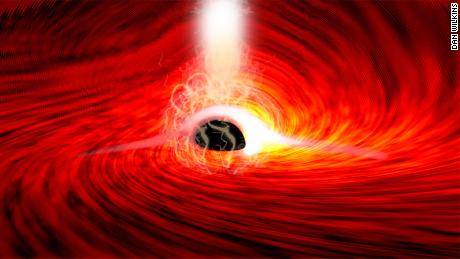Sign up for CNN's Wonder Theory science newsletter. Explore the universe with news on fascinating discoveries, scientific advancements and more .
(CNN) Black holes are one the universe's ultimate mysteries, hard to even imagine. But thanks to a recently released NASA image, we can visualize one a little bit better now.
Ghostly glowing rings were captured around a black hole by NASA's Chandra X-ray Observatory and Neil Gehrels Swift Observatory. The X-ray images reveal what would otherwise be invisible.
The black hole exists in a binary system with a companion star -- and the black hole's gravity is pulling material away from the star and into a disk around itself.
The black hole and star system is called V404 Cygni, and it's about 7,800 light-years from Earth. The star has about half the mass of our sun.
The space-based Swift Observatory, launched in 2004, detected an X-ray burst from the binary system in June 2015. This burst actually created energetic rings that are visible in the X-ray images.
Read More
Light echoes The phenomenon that created the rings are light echoes. They were created in this system when the burst of X-rays from the binary system reflected off of dust clouds scattered across space between the V404 Cygni system and Earth. Light detected behind a black hole for the first time Space is full of dust, but it's more akin to smoke filled with tiny solid particles. A new image released by NASA combines the X-rays observed by Chandra with data collected in optical light from the Pan-STARRS telescope in Hawaii, which fills in the surrounding stars. In 2015, Chandra observed the system on July 11 and 25, while Swift watched the system between June 30 and August 25. Eight rings created by X-rays from the 2015 flares can be seen as they bounce off dust clouds. These rings can help scientists to better understand the black hole within the V404 Cygni system as well as the cosmic space between the system and Earth. The diameter of the rings allows researchers to determine the distances of the dust clouds that were used to create the light rings. The larger the ring, the closer the cloud is to Earth. Putting X-rays to another use 'Pac-Man' in space: Black holes gobble up neutron stars in first evidence of a rare celestial event The researchers also used the X-rays in a similar way to how we utilize them for scanning in doctor's offices or luggage scans at the airport. This means they were able to utilize the brightness of the X-rays to determine the composition of the dust clouds based on how much of the X-rays they absorbed. The researchers found that the dust was likely made of graphite and silicate grains. The new image is another fascinating perspective of mysterious black holes and how X-ray observatories can illuminate otherwise invisible aspects of the universe.

